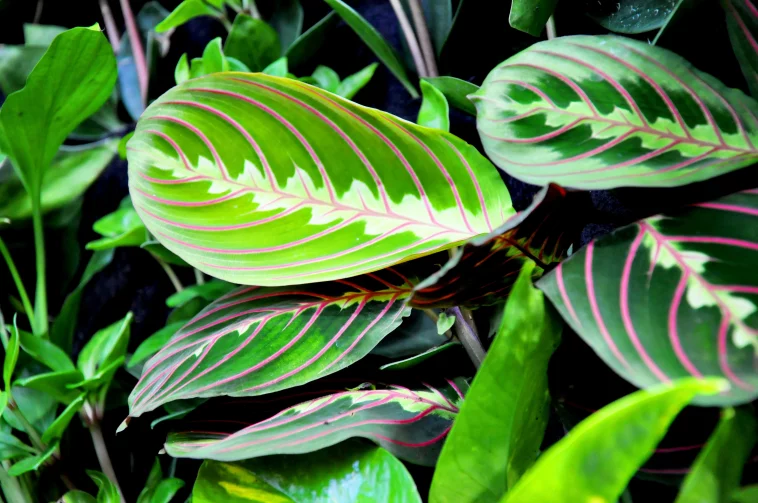The blossoms of the Prayer Plant are tiny and delicate, and they are white or purple in color. During the growth season of the plant, blooming is most common in the spring and summer months.
As unusual as it is to see a flower on a Prayer Plant in an indoor environment and although it doesn’t harm the plant, it may deter it from developing new foliage and kill off existing growth.
To help your Prayer Plant blossom, we’ll discuss the look of the blooms, the benefits and drawbacks of flowering, and some tips for getting your Prayer Plant to bloom. When considering whether or not to let your Prayer Plant to flower, there are a few factors to keep in mind.
Table of Contents
When do Prayer Plants Bloom?
When it comes to indoor Prayer Plants, the spring and summer months are the best times to see them blossom. Growing and dormancy phases occur in Prayer Plants, just as they do in many other types of plants. Because they adapt to the changing seasons, they develop the majority of their new growth during the warmer months. However, Prayer Plants have been known to bloom until autumn.
When growing a Prayer Plant, it is vital to note that it will not always blossom. A flowering indoor Prayer Plant is an uncommon sight to see. During the growth season, people have reported obtaining just a few blossoms from their plant, if any at all, according to their observations. In the event that you obtain a huge bloom from your Prayer Plant, it indicates that the plant has been cared for properly and is in good health.
Should You Let Your Prayer Plant Bloom?
Your decision on whether or not to let your Prayer Plant to blossom is entirely up to you. The plant will not care either way, but it may get combative if you attempt to restrict its blooming. Keep in mind, however, that there are a few factors to consider.
The blossoms are a rare and magnificent sight to see. This despite the fact that they are easily obscured by the vivid foliage, which is much more vibrant and beautiful. When in bloom, Prayer Plants devote all of their energy to the development of their blooms, which might result in the death of older leaves. Someone who grows Prayer Plants just for their leaves may find this to be a source of frustration.
It’s also possible that with huge Prayer Plants, the amount of blossoms they produce is a problem. The blooms die swiftly and regrow quickly, allowing the wilted blossoms to amass quickly. This may be a chore to keep up with depending on how much time you have available for upkeep.
Despite this, Prayer Plant flowers are beautiful. Flowering is not harmful to the plant, so if you aren’t bothered about the plant’s leaves changing, you may be able to appreciate the little flowers as they develop over time. Blooming is a normal occurrence and a sign of a healthy plant.
Inhibiting the flowering of your Prayer Plant will redirect all of the plant’s energy to the growth of new leaves. All that will be required of you will be to delicately clip back the stems when they emerge. The plant will eventually quit growing new stalks as time goes on. Pinch the stalks back with clean hands alone.
How Do Prayer Plant Flowers Look?
When grown inside, Prayer Plants may produce blooms, which is an unusual occurrence. Flowers appear at the ends of the Prayer Plant’s long, thin stalks when it’s in full bloom. The blossoms may be either white or purple in color. Because each blossom is bilaterally symmetrical, they have a form that is similar to that of snapdragons or sweet peas.
Depending on the species, it may be difficult to detect the scent of the plant’s blossoms. If you’re lucky enough to be able to smell it, the blossoms have a delicately pleasant scent.
Flowers may endure for many months after they are planted. However, the blossoms only last a few days before dying. When the flowers get too wilted, they fall off. Most of the time, new flowers quickly take their place.
It is common for Prayer Plant growers to only get a few stalks or blooms, and then the plant ceases to bloom completely. Many others have reported seeing large numbers of flowers that had to be picked up on a regular basis. Depending on the plant’s size and health, this might vary. Prayer Plants that are more mature tend to produce bigger blooms, however this is not always the case.
Are Seeds Produced by Prayer Plant Flowers?
The short answer to this question is yes. Seeds are produced by all blooming plants. You may develop a large number of fresh Prayer Plant plants if you are ready to put in the necessary time and effort to gather Prayer Plant seeds. However, gathering the seeds will be a challenge since they are so little. And, as I’ve already said, the blooms are quite uncommon, and harvesting healthy seeds is likely much more difficult.
Propagation through cuttings is a more effective method of increasing the number of Prayer Plants available. This technique of propagation is considerably easier to use and does not need the same amount of time and effort as gathering, drying, and finally planting seeds, among other things. Prayer Plants are extremely easy to reproduce, making them an excellent choice for first-time plant owners.
How to Get Your Prayer Plants to Bloom
There are a few methods to encourage your Prayer Plant to blossom if you are eager. The most straightforward method is to ensure that your plant’s requirements are satisfied in full. Prayer Plants are native to tropical locations, such as Brazil, and flourish in environments that are similar to those found in these environments.
A Prayer Plant thrives in bright, indirect sunshine, which is ideal. Despite the fact that they can endure a lack of light, it will not be sufficient for the plant to flower. On the other hand, too much sunshine may cause the leaves to get burnt and the color of the leaves to fade. When it comes to helping a Prayer Plant to blossom, striking the perfect balance is critical.
Additionally, prayer plants demand high humidity. A well-lit bathroom, like with other high-humidity plants, is an excellent spot to keep one of these plants inside. A pebble tray is another choice; but, if you have the financial resources, humidifiers are the greatest option to consider.
Regular fertilization is another critical step in getting a Prayer Plant to blossom. A diluted water-based fertilizer should be used to feed prayer plants every two weeks throughout their growth phase.
Make certain that the fertilizer is adequately diluted—Prayer Plants are prone to developing dark patches and splotches on their foliage if they are overfed with nitrogen. Not providing adequate fertilizer to a Prayer Plant might cause the plant to establish new growth to be slowed or entirely stopped.
Conclusion
It is totally up to you to decide whether or not you want to prevent your Prayer Plant from blooming. Just remember that a profusion of blooms is a wonderful indication that your Prayer Plant is enjoying the attention it is receiving. Plus, the blooms are spectacular. In spite of their small size, these flowers make the plant look different from the rest. They are worth seeing at least once.
Do not worry if you don’t like it or your Prayer Plant’s last bloom was a mess. Just pinch back the new stalks. Fortunately, plants are reactive, and yours will adapt rather fast once it realizes that you do not want it to blossom. Don’t rush things; just be patient and make sure everything is in order.
You don’t have to worry about your Prayer Plant if it isn’t flowering. This is a somewhat uncommon occurrence. Continue to take care of your plant as you normally would. They take years for some Prayer Plants, if they ever flower. Consistency is very important for any plant. Making certain that your Prayer Plant’s requirements are satisfied, as well as providing it with sufficient time, may result in a spectacular bloom!
Photo by form PxHere



